And now, a few weeks later, we receive a notification by e-mail that our test is ready, the results have been uploaded to the site and now you can see its result!
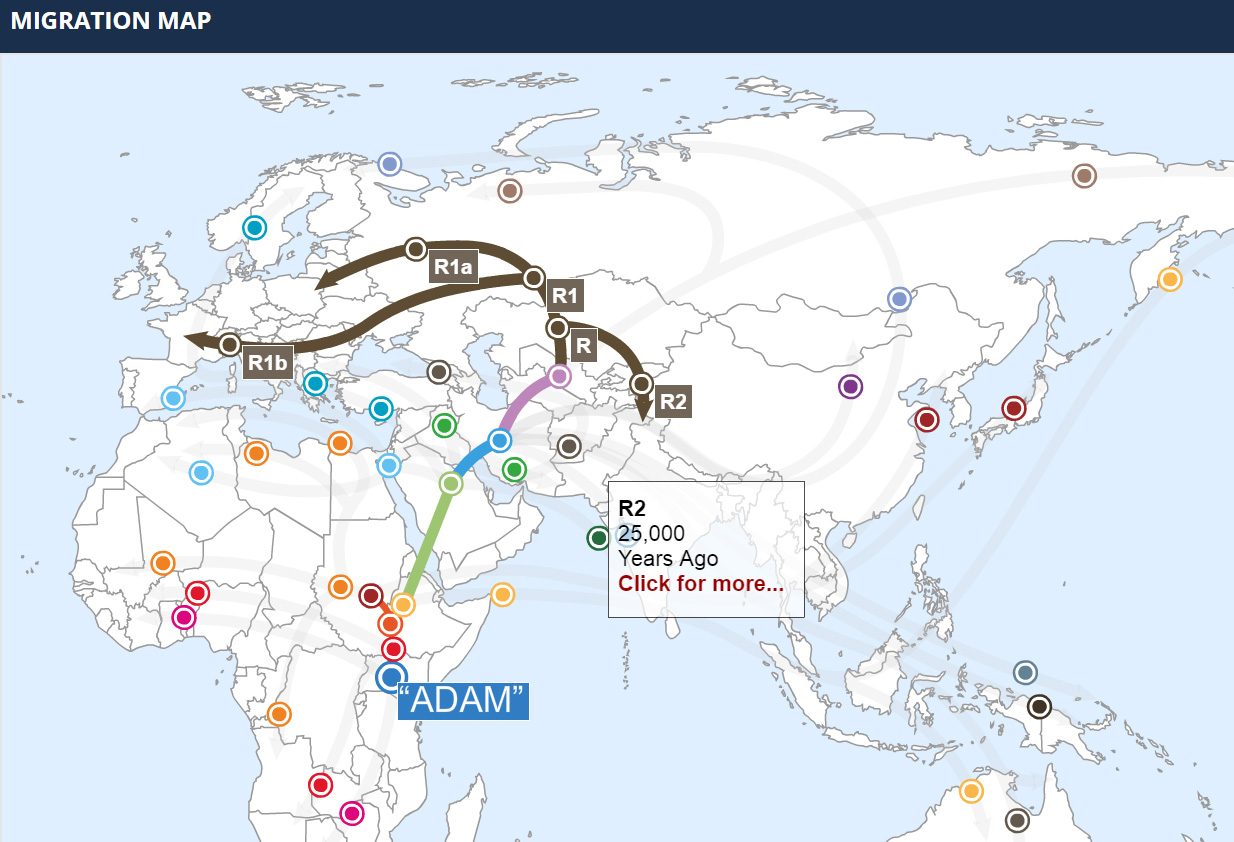
What will we see in the DNA test results on the laboratory's website?
Before looking directly at the results, I would recommend filling out a profile on the laboratory's website.
Suppose you found a potential relative, decide to write him a letter, he will look at your profile and will not understand who is writing to him and what is your awareness of your ancestors, the language you speak, and so on. Therefore, do not be too lazy to register your last name and first name, the last names of your ancestors, which you know, the regions of their residence, some sites suggest indicating your oldest known ancestor. The advantage will be that the sites will compare the names of interest you indicated with those indicated by other participants, so do not be too lazy to indicate them both in Russian and in English. You can also upload your photo. Only those with whom you have a match will see it.
, .. .
The first and simplest thing we can see in the results is the “origin”.
Based on the comparison of millions of tests, DNA laboratories predict your origin, more precisely the origin of your ancestors. These results are approximate enough, so personally I think this is not a very interesting test, unless you are adopted and do not know where your ancestors are from. Although for some peoples this is important.
Below in the gallery is an example of displaying the "origin" of the same person in the first three laboratories and another person - in 23andMe:

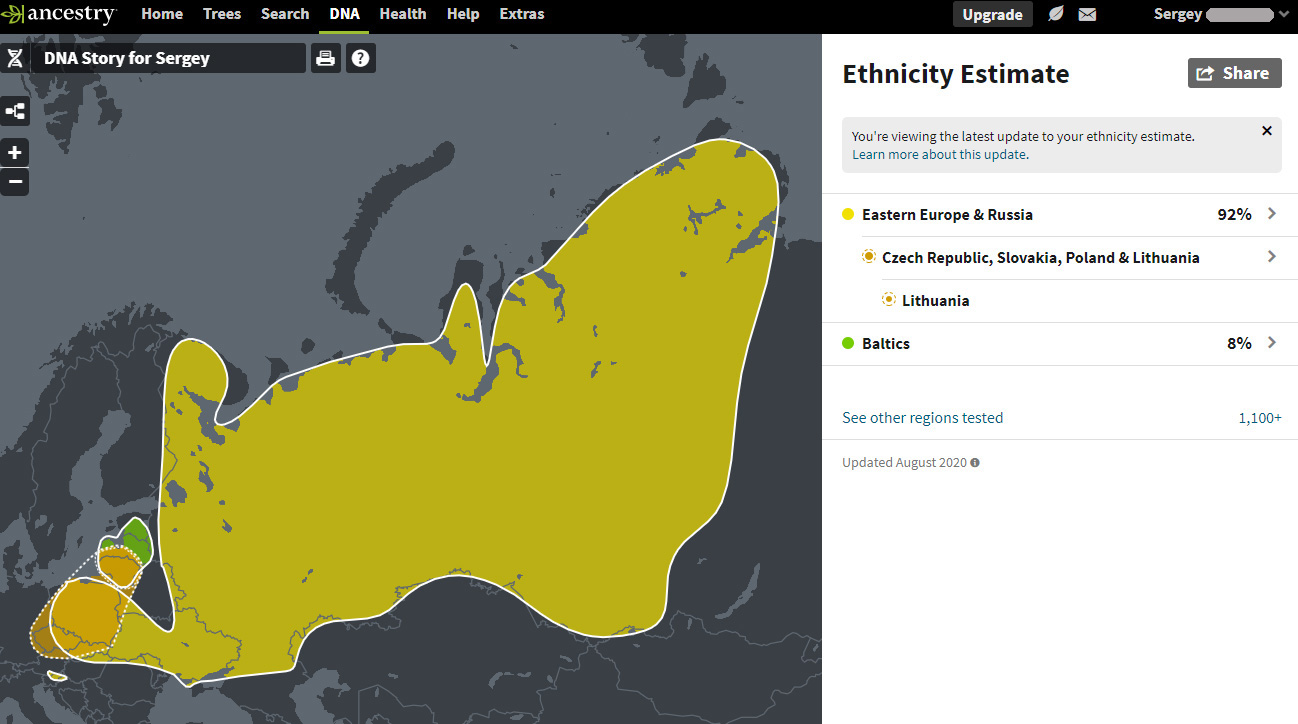
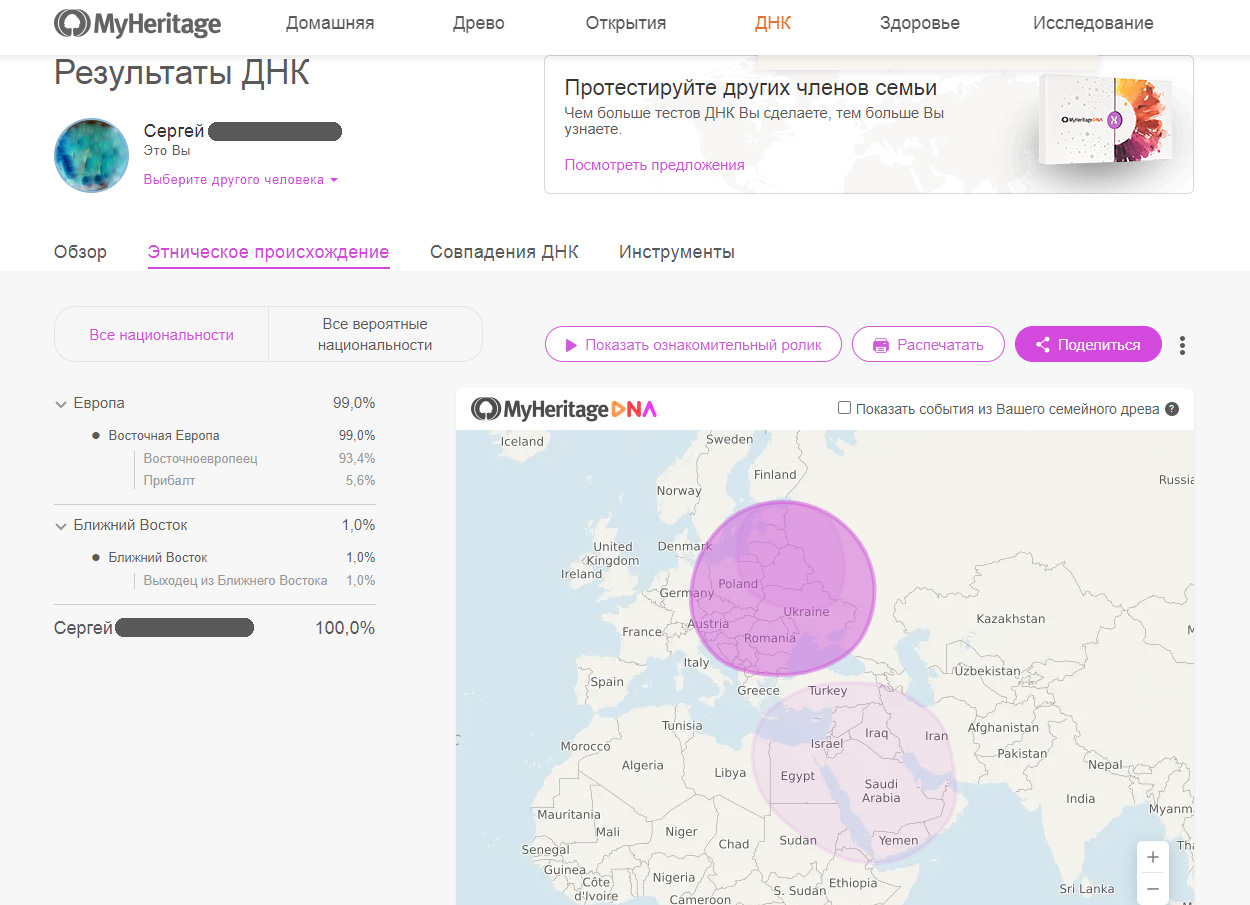
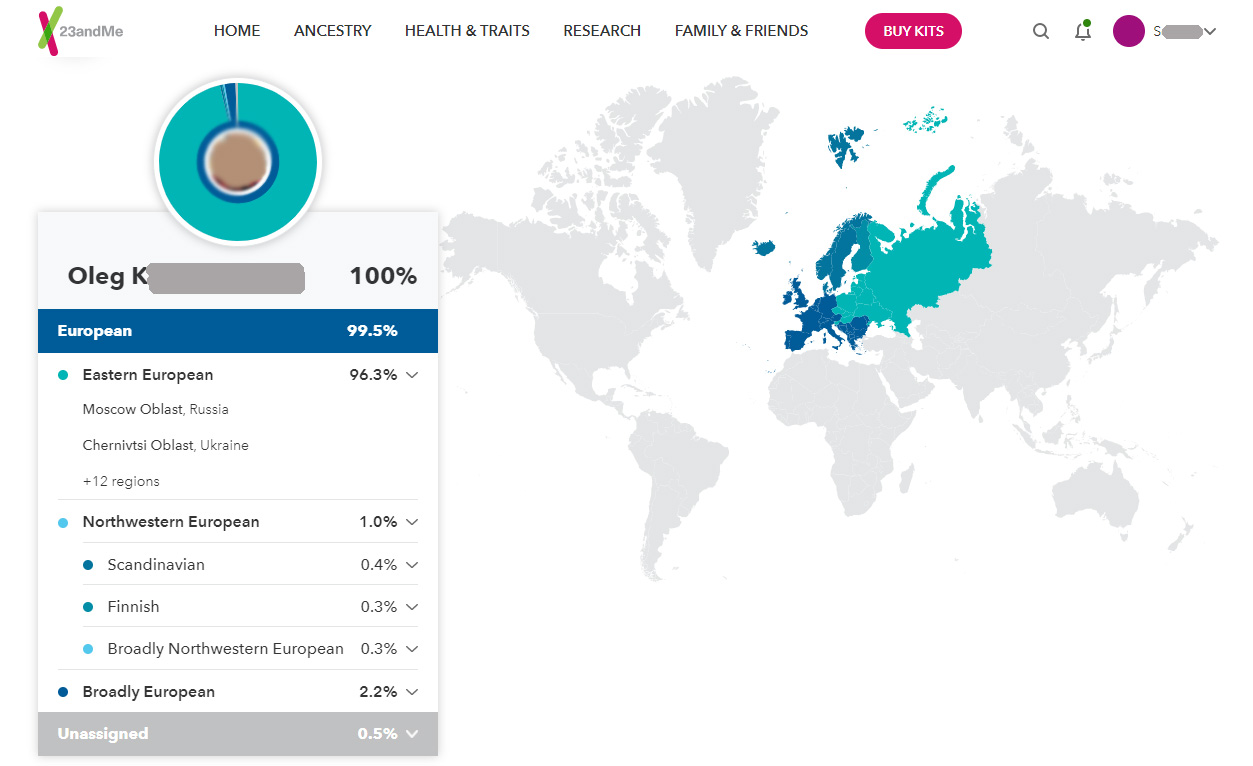
"Origin" is based on analysis and comparison, therefore, with constant replenishment of the database with tests of other people, the algorithms periodically adjust the origin. Slightly, but nonetheless.
, “Family Finder”
Matching is exactly what everyone does the test for. In order to find lost relatives or fill gaps in information about their ancestors.
Before looking at the results, you need to delve into the theory at least a little and understand what percentage of coincidence or what number of CM indicates what approximately generation with a common ancestor.
The autosomal test, also called the “Family Finder”, shows all “matchmakers” who have common ancestors at a depth of about 8-10 generations. That is, each of us at the depth of the 3rd generation (great-grandfathers / great-grandmothers) has 8 direct ancestors, and at the depth of the 8th generation - already up to 256 direct blood ancestors (taking into account the repetition of ancestors at such a depth for many living today)... From each of these 256 ancestors there were descendants, far from one. And all the descendants who have survived to this day, and who passed the test, will come out as matches on the websites of DNA laboratories.
The closer the relative - the higher the percentage of coincidence, the lower the percentage - the further, but he is probably your relative! The only question is in which generation and in which branch ... and this is the most difficult question.
It is to understand which branch is the coincidence and it is recommended to do the test not only for yourself, but also for your grandmothers, grandfathers and other relatives, in order to compare the "coincident" (with the supposed common ancestor in the 4th-5th generation) with the tests of living parents or grandmothers / grandfathers, and not just with themselves.
View matches for DNA test “Family Finder”
I erased the names and contacts of people in the lists, so the screenshots suffered a little aesthetically. Test "23andMe" - a different person.
View ANCESTRY Autosomal DNA Test Results

We see a list of "coincidences", in fact - relatives, we see a certain number of total DNA measured in "CM". The site makes a prediction by the degree of kinship, for example "4-6 cousin / sister (cousin)". Why such a spread - again, we read the theory that I wrote earlier . The percentage of the same DNA can be both with a relative on the same timeline, so it can be a couple of generations older than you, but then closer along the branches of the "tree".
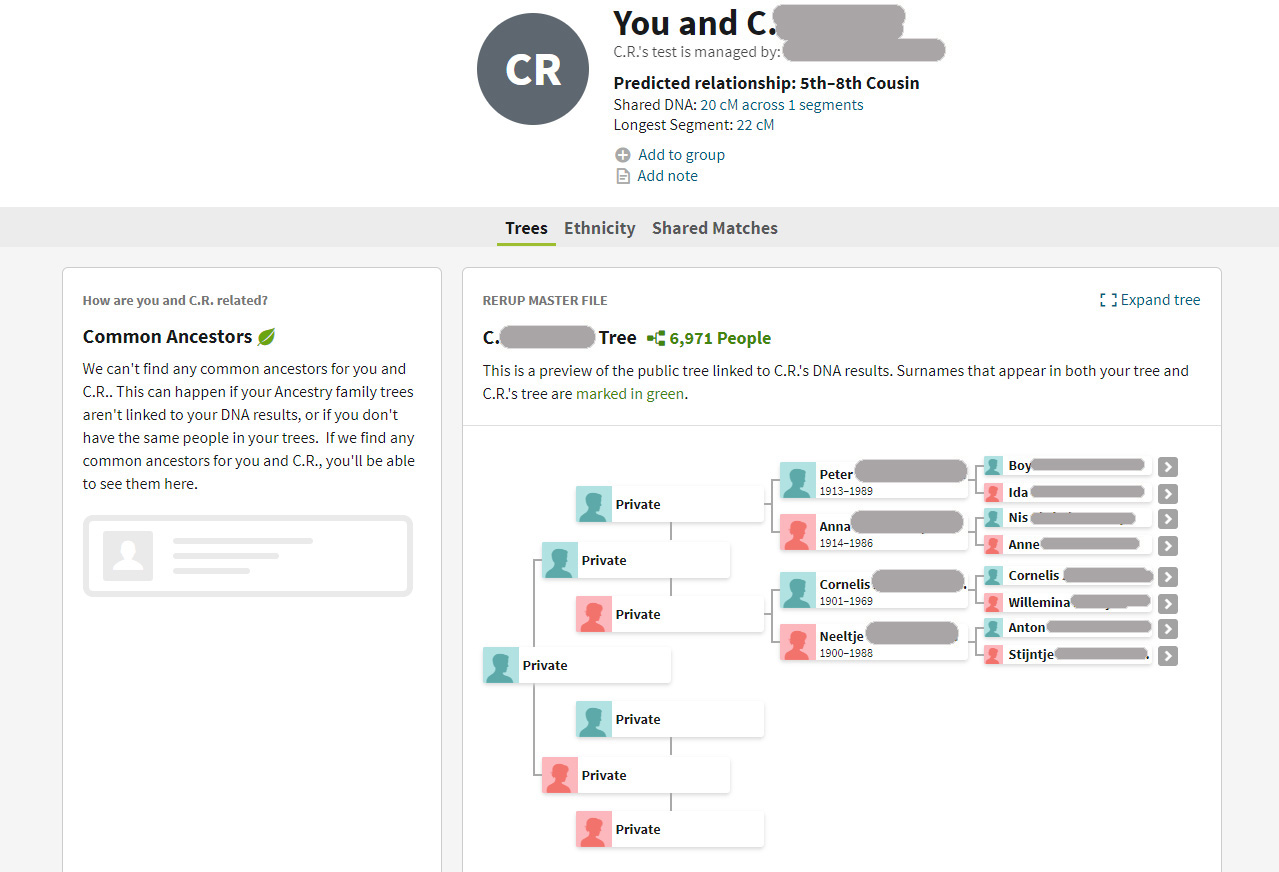
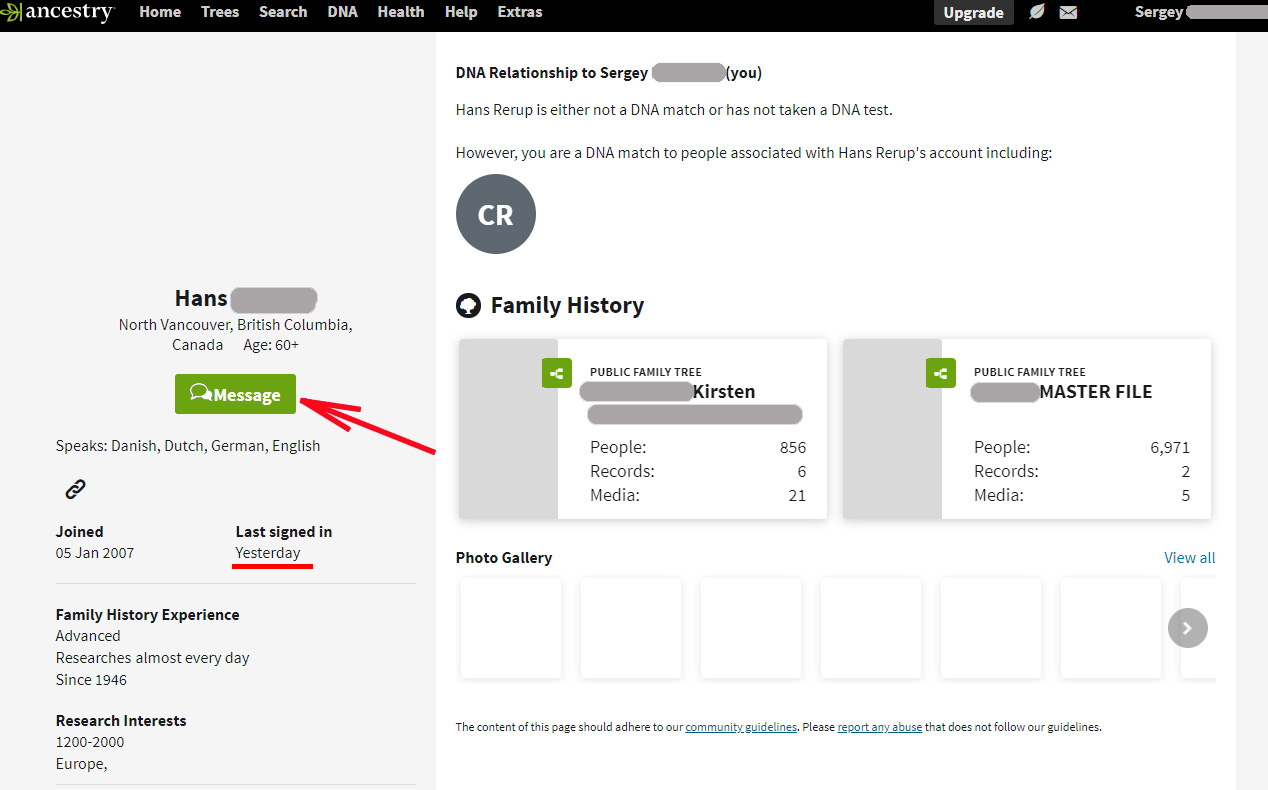
By clicking on the last name of interest, you will see in more detail his name, the estimated degree of relationship, the general DNA match and the largest matching segment. Many have compiled on this site "family trees" and you can view them, as a rule, they are open, but you will not see alive without the approval of the owner of the "tree". Trees can be very large, you can dig in different branches from the "coincidence" upwards and look for familiar surnames. Sometimes trees are closed. Filtering, search is available.
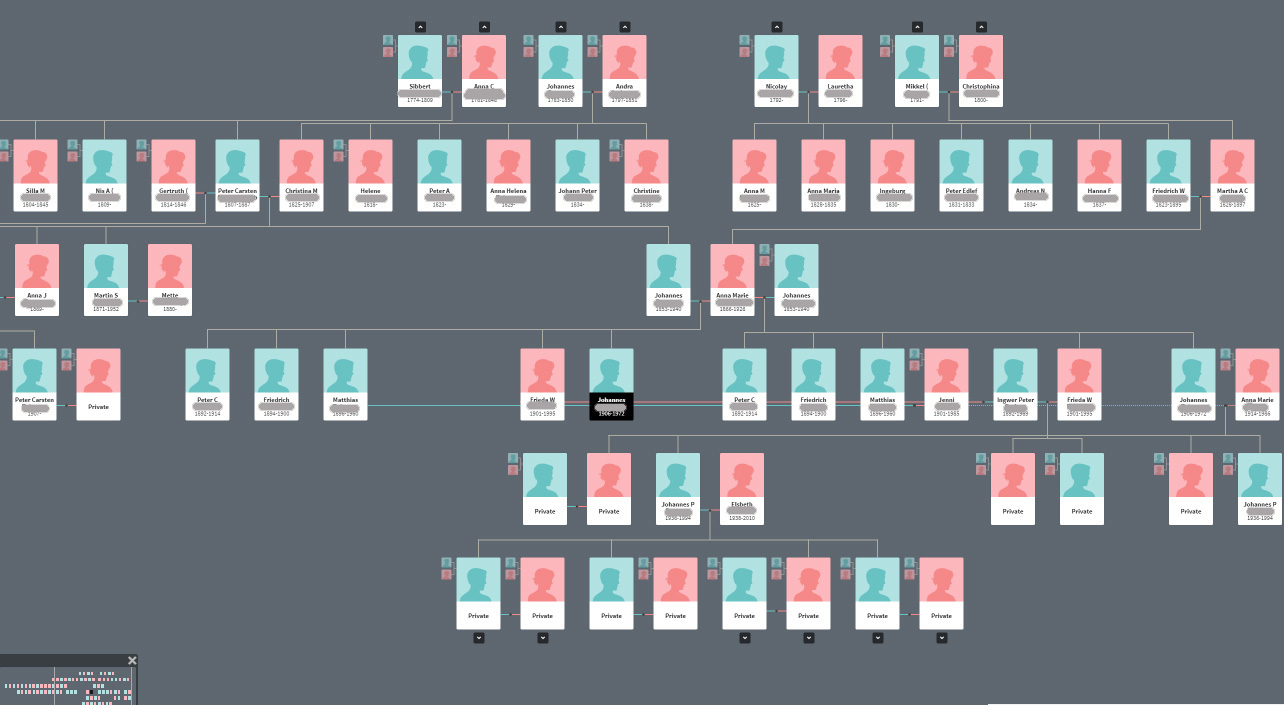
Of course, from the profile of the "coincident" you can write him a message, introduce yourself, offer to look for common ancestors in the dialogue. Here you can see what language a person speaks, when he was last on the site, his areas of interest and the available “trees”.
You can write to a person only directly from the site, a special section has been made for communication in the form of "chats". When new letters appear, notifications are sent to the mail, but whether a person comes in on these notifications and reads your message depends on the person.
In “Ancestry” you cannot download the result of a test taken in another laboratory, similarly to “23andMe”. Hence the small number of Slavic surnames in the test results.
View 23andMe Autosomal DNA Test Results
The interface "23andMe" is very rich and the possibilities to expand the study of your DNA are quite wide, although you will have to pay extra for each "option". I'll cover the basics so I can compare with the rest of the labs.
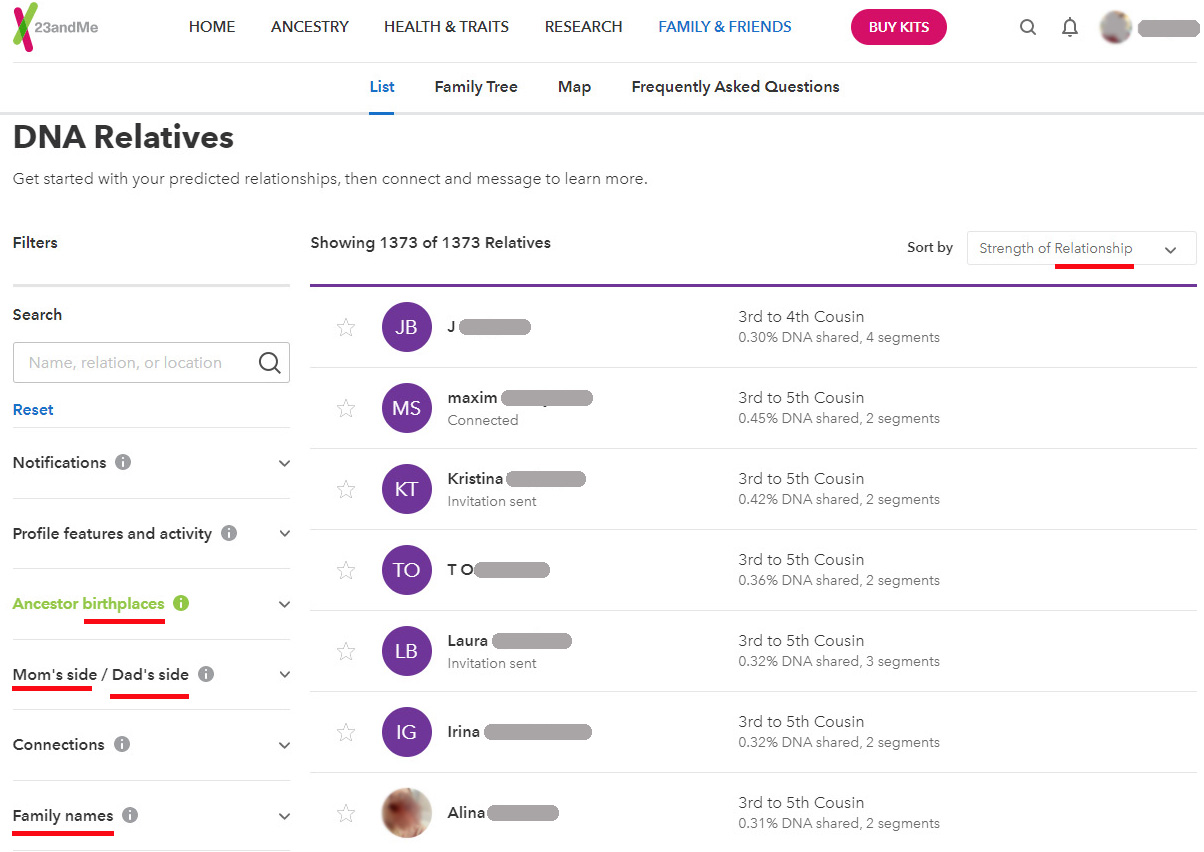
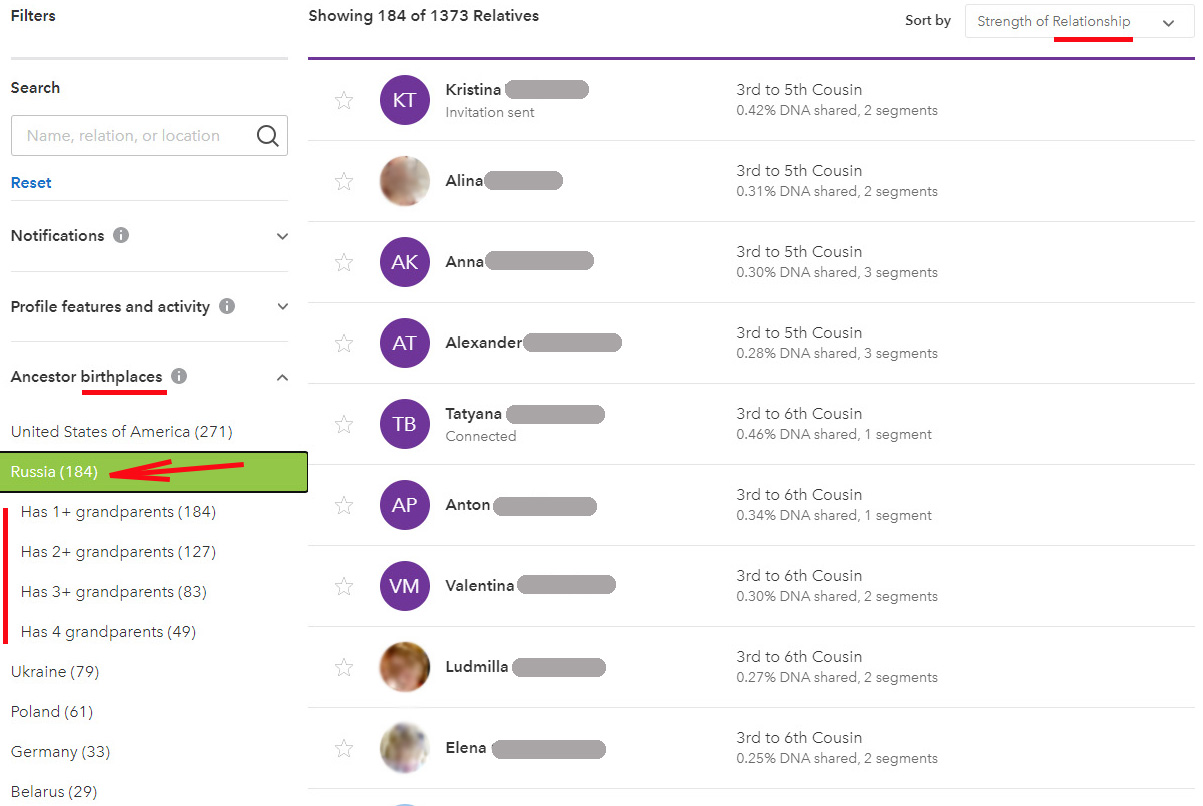

A DNA match list is a list of names with an assumed degree of relationship and a shared DNA percentage. There is a very rich system of filters that work, of course, provided that the one who downloaded the test filled out his profile as fully as possible.
For example, you can choose the country of origin of the ancestors of the "coincident", and not just, but in what generation his ancestor comes from a particular country. You can not just type a surname into the search, but automatically see a list of the most frequent surnames among those that coincide with you and filter them in "two clicks". If you have ancestor tests on the maternal and paternal lines, sorting takes place, you can immediately see who is on the paternal side and who is on the maternal side. You can see "coincidences" on the map and from there reveal their profile with details.

By clicking on a person in the list, we get his name, photo, year of birth and when the person was last on the site, it helps. Immediately, the degree of alleged kinship is visually shown on the diagram (in "MyHeritage" it will be the same, but there it is a little less conveniently "hidden" in the interface).
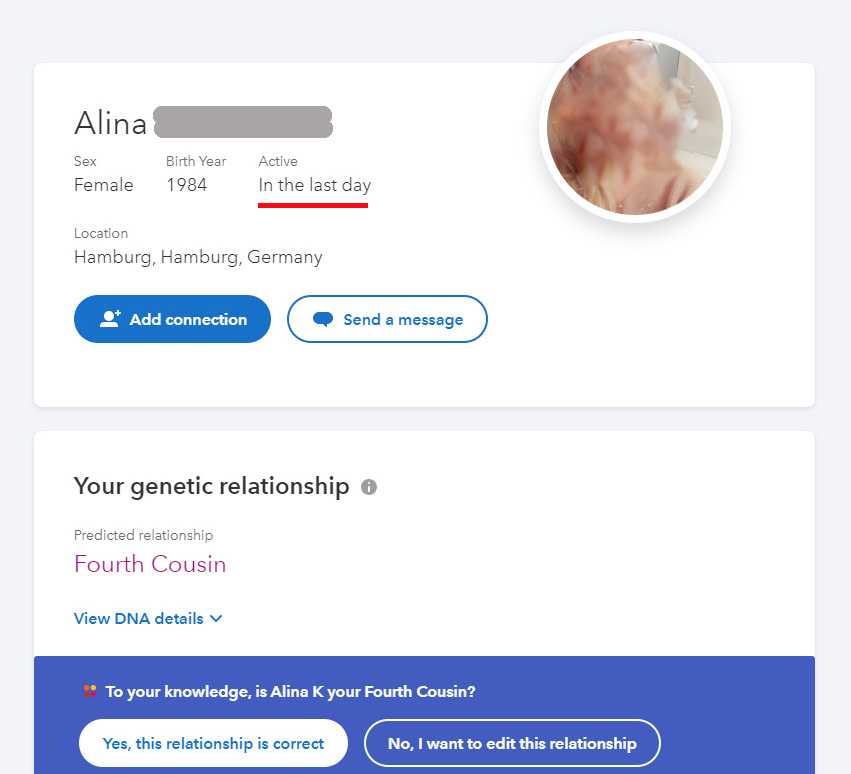

The profile of the "coincident" does not just indicate the surnames and places of birth of the ancestors separated by commas, like all others below, but these surnames and places of birth are spaced along different lines with the indication "maternal grandmother" or "paternal grandfather." This eliminates unnecessary clarifications, everything is clear at once! It is possible to attach a link to your family tree, and surprisingly, a third-party resource is allowed (in the screenshot, a link to the tree on "MyHeritage"). Directly on its website, "23andMe" also allows you to draw a tree, and it is pretty pretty.
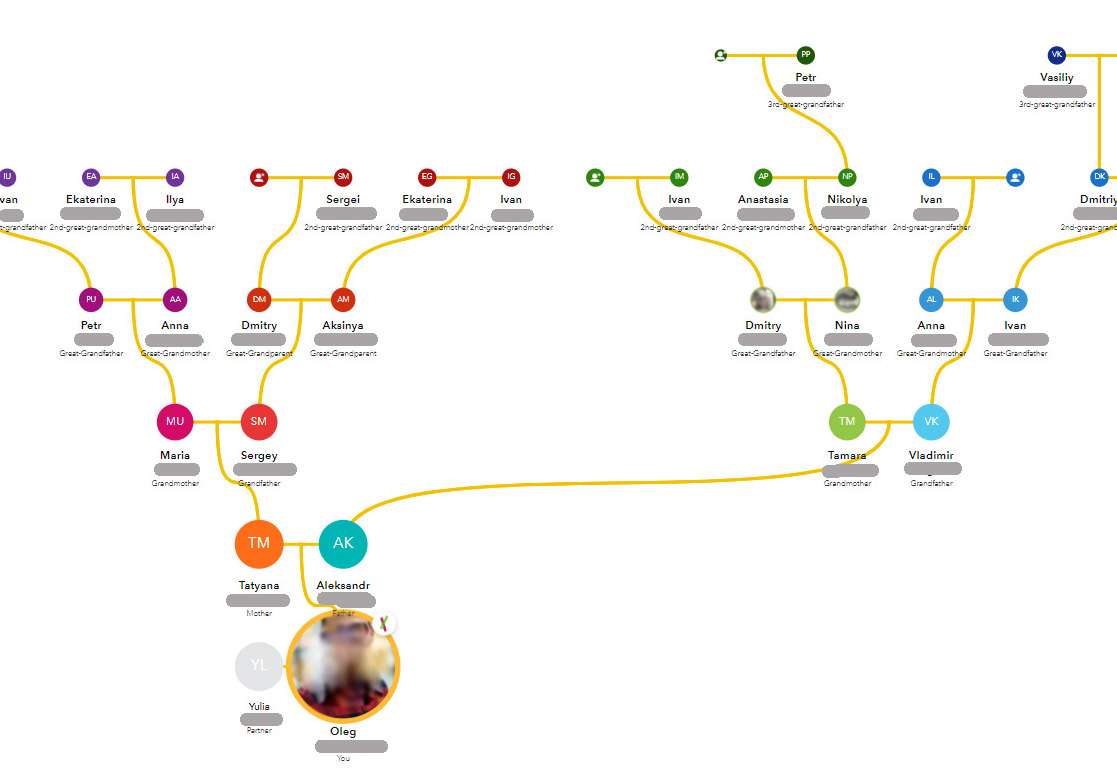
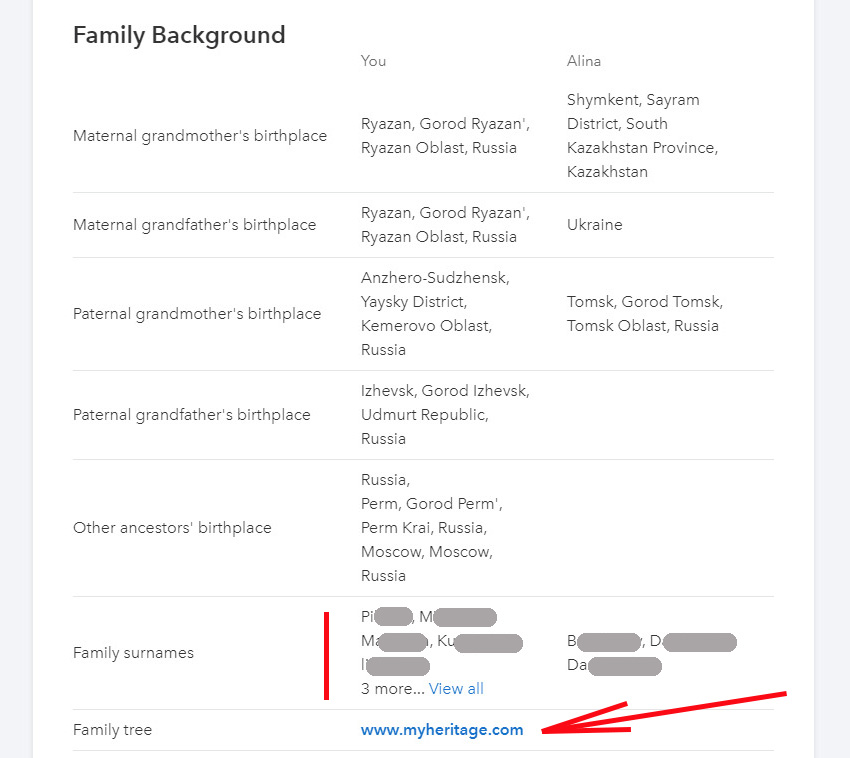
The most important feature of "23andMe" is the definition of both paternal and maternal haplogroups in the base cost of the test without additional payment! Well, when you look at the match with a certain person, the haplogroups are immediately compared.
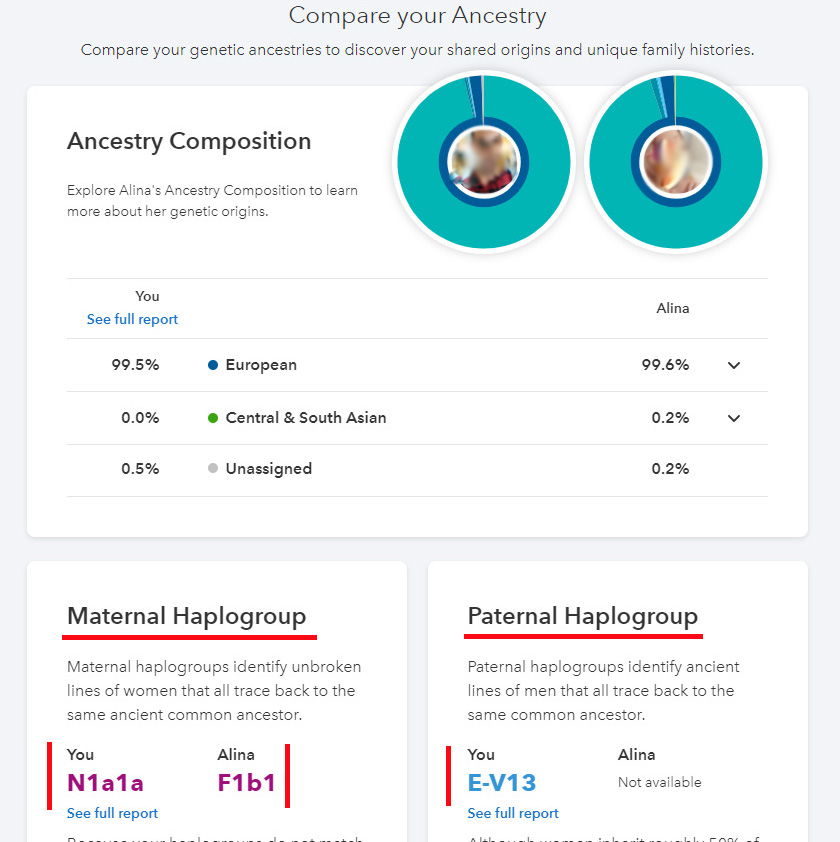
Right on the site, you can write to a person and look for common ancestors. When new letters appear on the site, notifications are sent to the mail.
In 23andMe, you cannot load the result of a test taken in another laboratory, as in Ancestry. Considering that the test cannot be ordered directly to Russia or Ukraine and cannot be sent back from these territories, the number of those tested with ancestors from the USSR is very small.
View MyHeritage Autosomal DNA Test Results
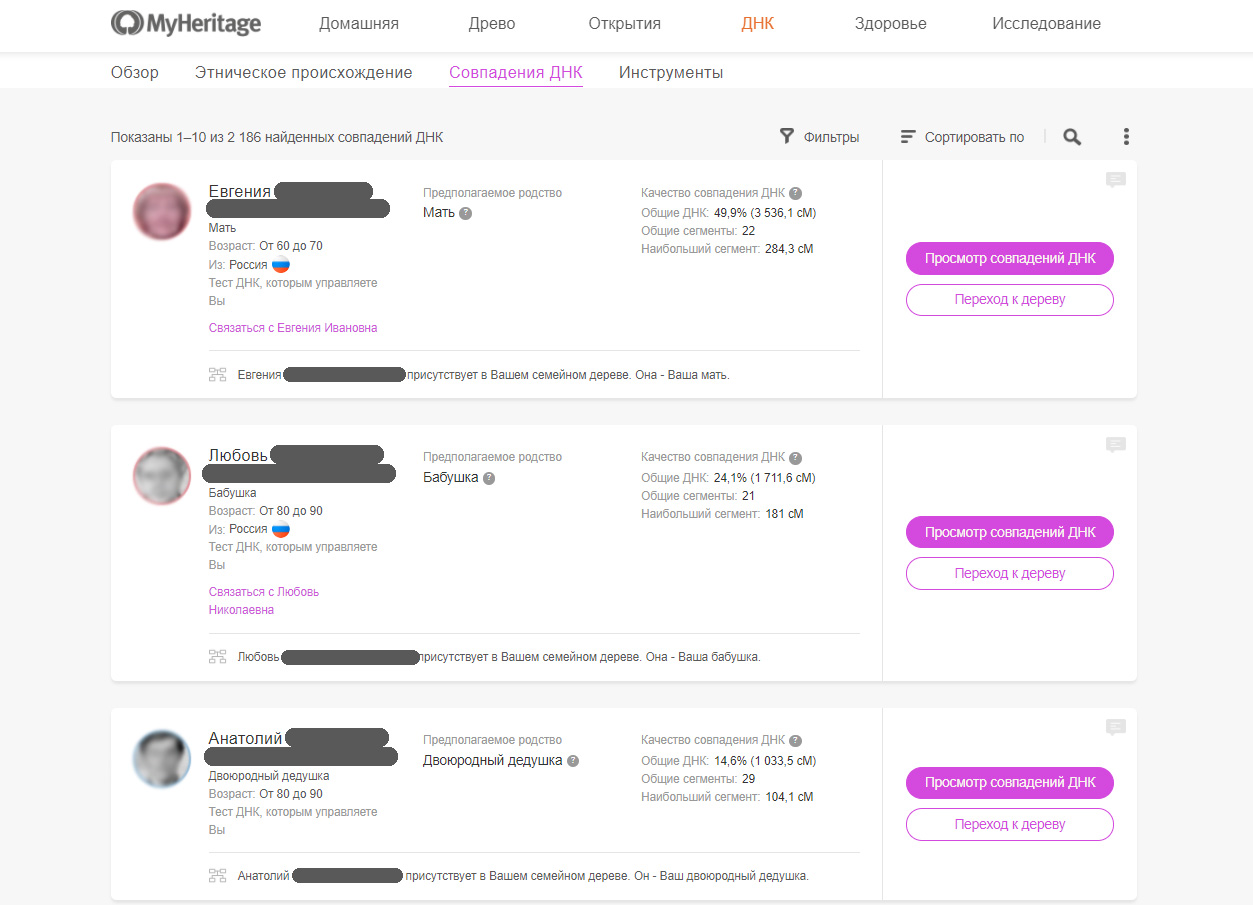

The slight difference between “MyHeritage” and others is that it is not necessary for each test taker to create a “personal account” and a separate profile with the result. If you already have your own profile and a tree has been drawn up on the site, then you can simply "tie" the new results of relatives to the relatives in your tree. Accordingly, the results can be viewed for each of the loaded tests in a couple of clicks without leaving your profile. On other sites, you need to log out and log in under the login of the person whose test was done. And the site is Russified, it is convenient for those who do not speak English.
In the list of matches, everything is the same, but in a slightly different interface. If these are your tests and they are linked by you in a tree, the degree of relationship according to your own tree is immediately shown.
Shown is the estimated relationship, the "cM" number and as a percentage of total DNA. How to compare interest and "cM", again, I said earlier . Filtering, search is available, everything is like everywhere else.

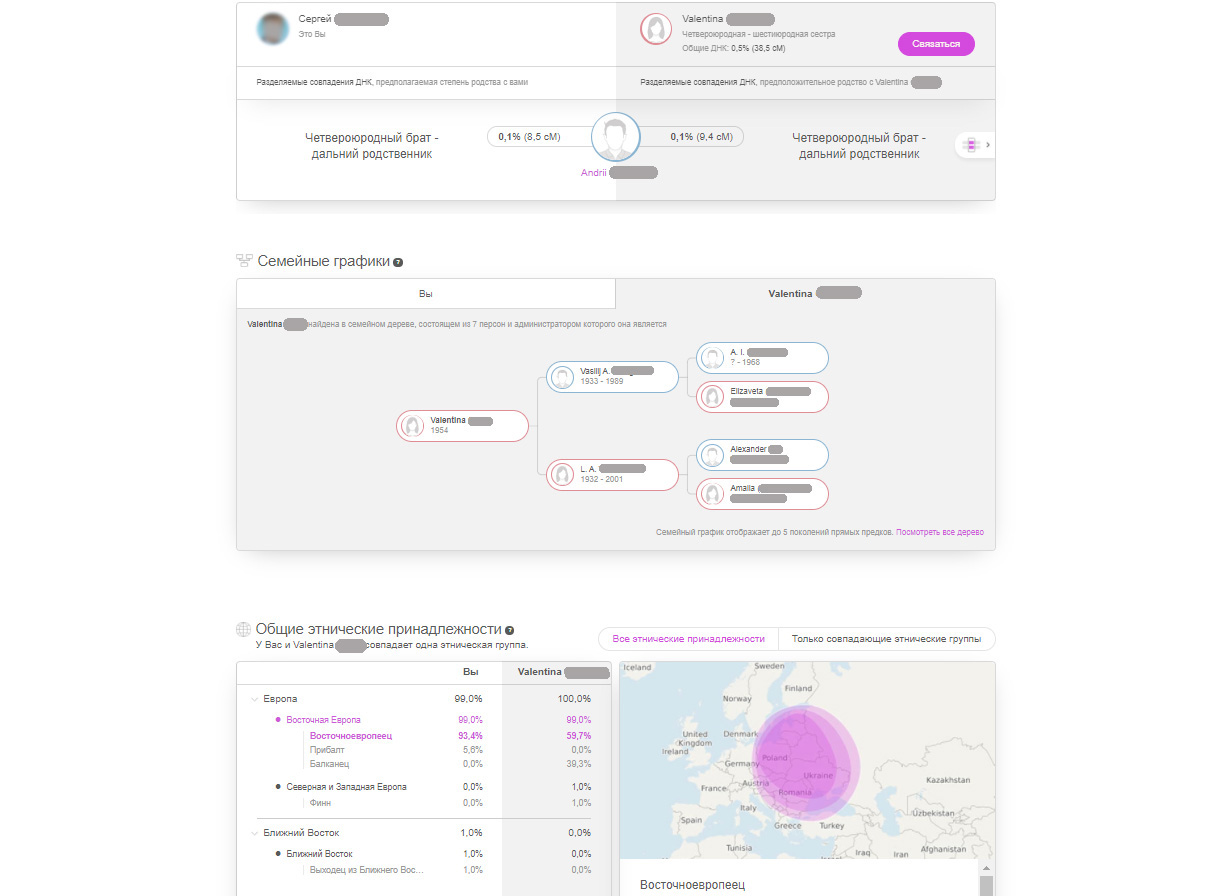
By clicking on "View DNA matches" you will be taken to a detailed comparison of the match between you and the person of interest. You will see the details on the DNA match, the names of interest indicated by the person in his profile, as well as below the list of people whose DNA matches both you and this person. This, among other things, will allow choosing a test of an ancestor known to you (for example, a grandmother), and it is guaranteed to see below matches exactly along her line.
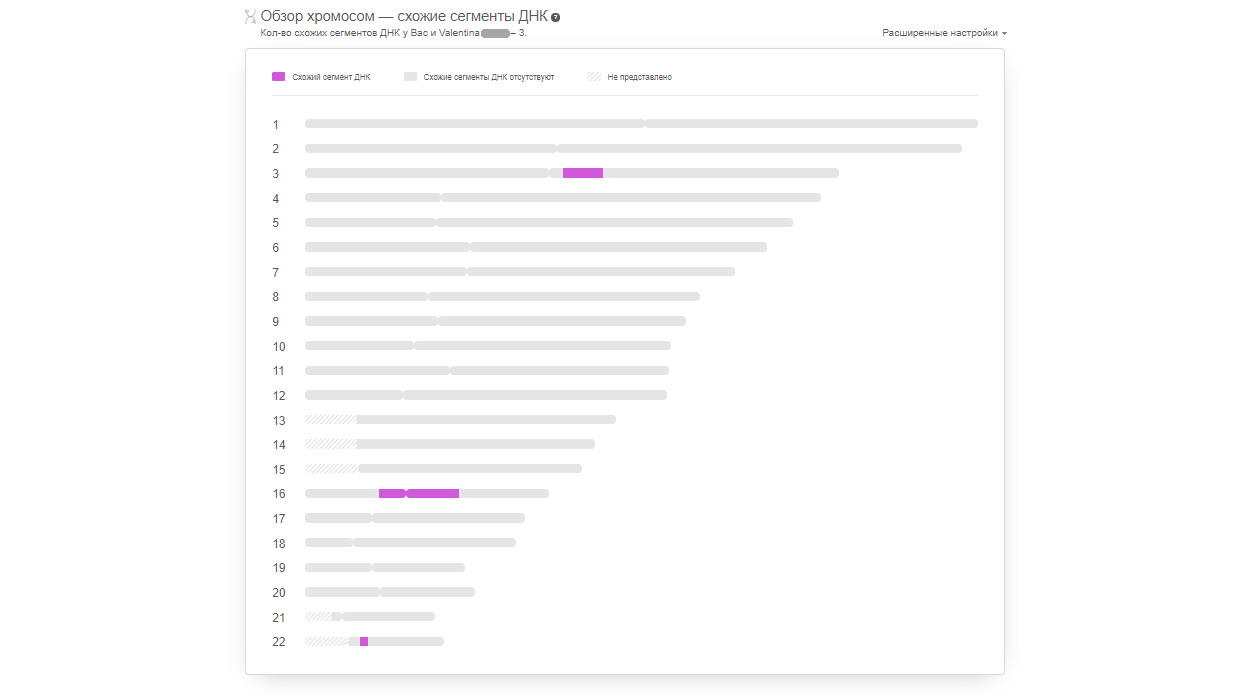
A very good tool is finding triangulated segments. You choose a couple of people other than yourself and compare the DNA. If all three drop the same fragment, this is already guaranteed to be your relative in this branch. But in addition to your test, you need to have tests of relatives, so that you have someone to compare with.
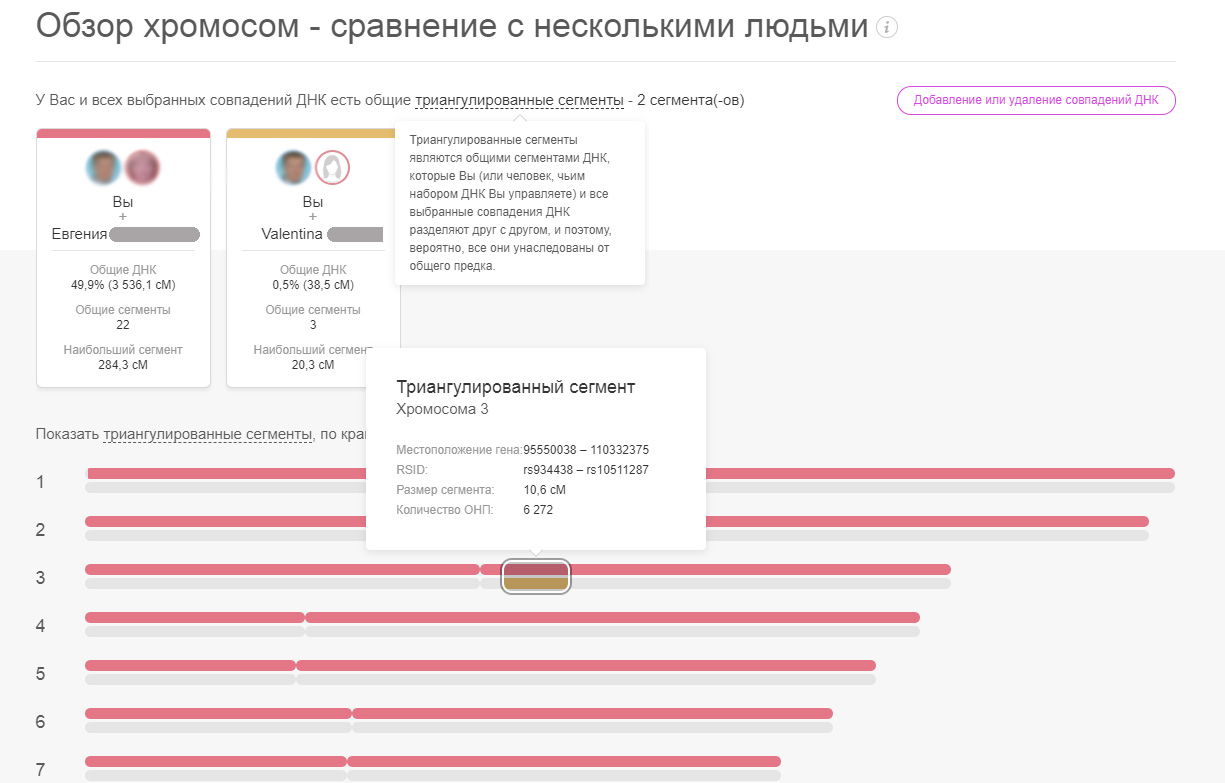
Similarly, with “Ancestry”, a part of the “tree” will be visible, if a person has it on the site, which can be opened and viewed in more detail, and the “origin” is also compared and common parts of DNA are shown.
The appearance of the tree can be seen in the last 2 screenshots. In general, of all the online services I tested, I find it the most convenient. As for someone else's tree at the "coincidences", if it is not closed, you will see all the dead, and if you have additional information and a photo, you can read it. If closed, you can request access and, after approval, see the entire tree in full.
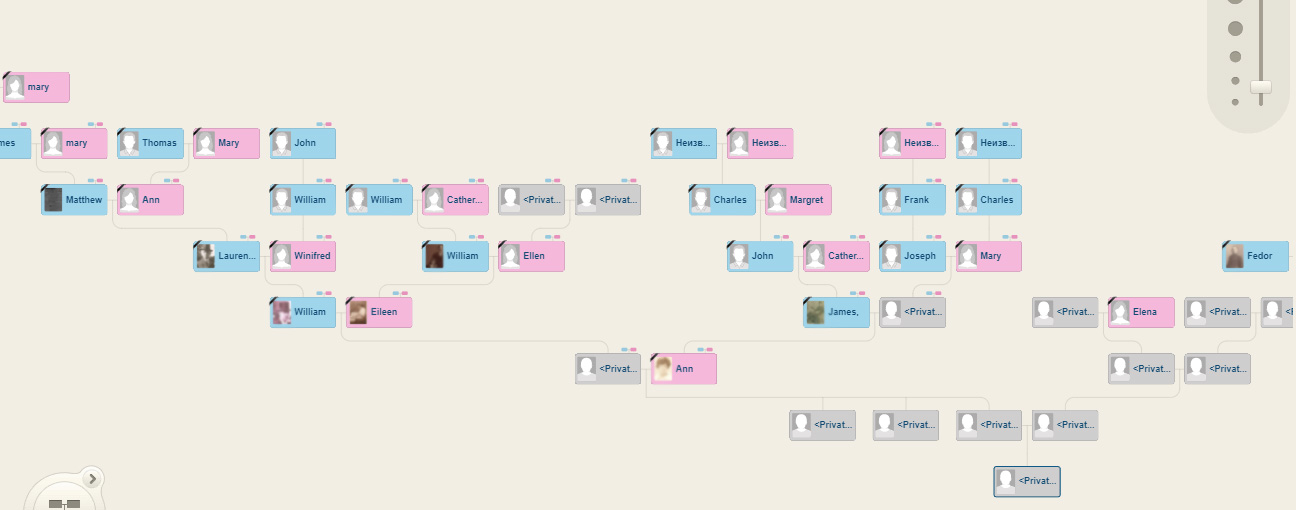

You can write to a person directly on the site, it is convenient, but this is also a disadvantage, since a person may not see a notification in the mail about a new message on the site, and he has not visited the site for a long time.
In “MyHeritage” you can download the result of a test taken in another laboratory, see below.
View Autosomal DNA Test Results from FamilyTreeDNA
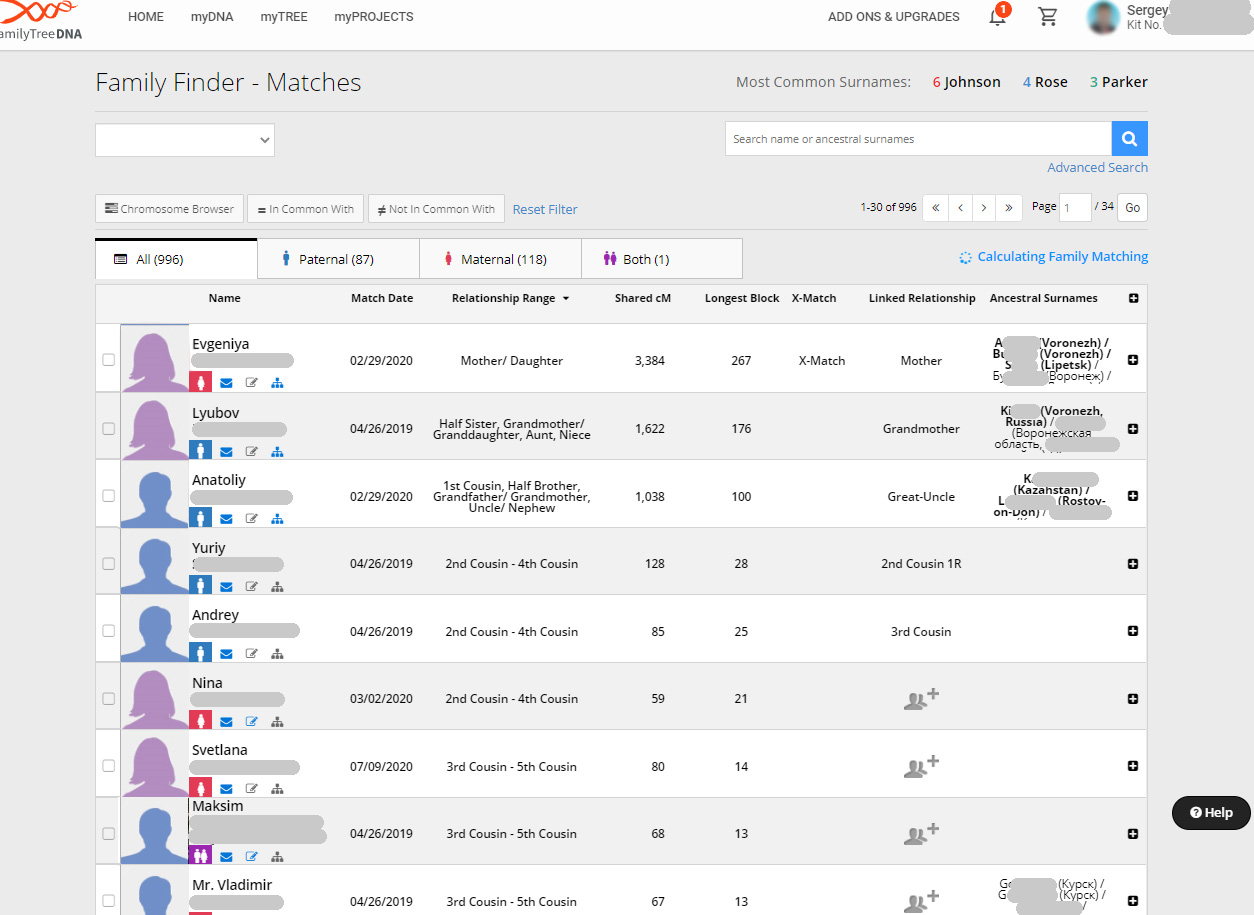
"FamilyTreeDNA" ( short for "FTDNA" ) is perhaps the most convenient to work with a list of "matches". But everything is subjective. We are also offered a complete list of close and distant relatives with the date of coincidence (the first date according to the date you loaded your test, then as new people appear - the date of adding their test), the estimated degree of relationship, common DNA measured in "cM" and the length of the longest segment matched DNA, and if a person indicated in his profile - a list of surnames from among his ancestors.
There is also an opportunity to build a "tree" and when "linking" the test to someone from your tree - this is indicated in the penultimate column - "Linked Relationship".
Another important feature of “FTDNA” is that if there are “tied” relatives in the database on both the male and your female lines, all “matches” are automatically sorted by the “Paternal” and “Maternal” tabs, which simplifies filtering and understanding which line look for common ancestors.
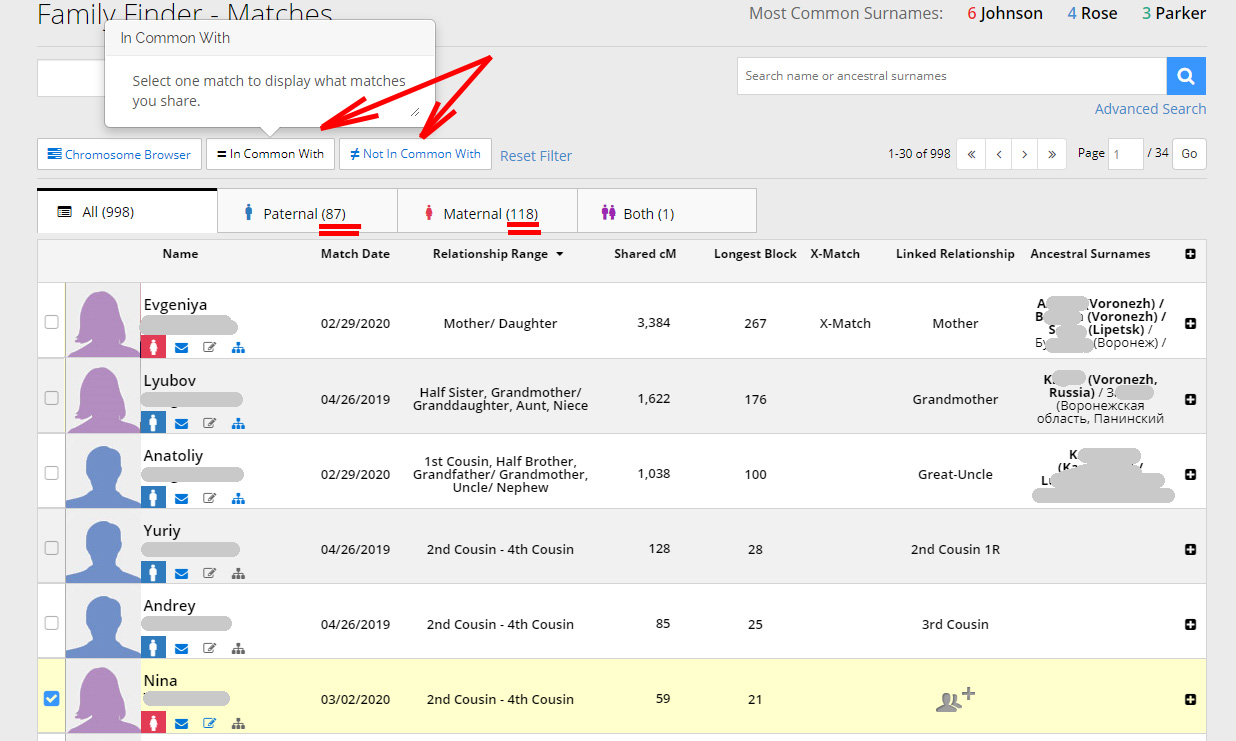
By clicking on a person, you will see the information he entered on the oldest known ancestors, a list of the names and regions of residence of the ancestors, his haplogroup, if you did the Y-test and the Mt-test, as well as an e-mail for communication. Unlike “MyHeritage” and “Ancestry” - here people immediately indicate their e-mail for communication. Your communication will take place outside the FTDNA website, and in practice it is more convenient, and the percentage of “dead” e-mails is lower than the percentage of unanswered messages on the websites “MyHeritage” and “Ancestry”.
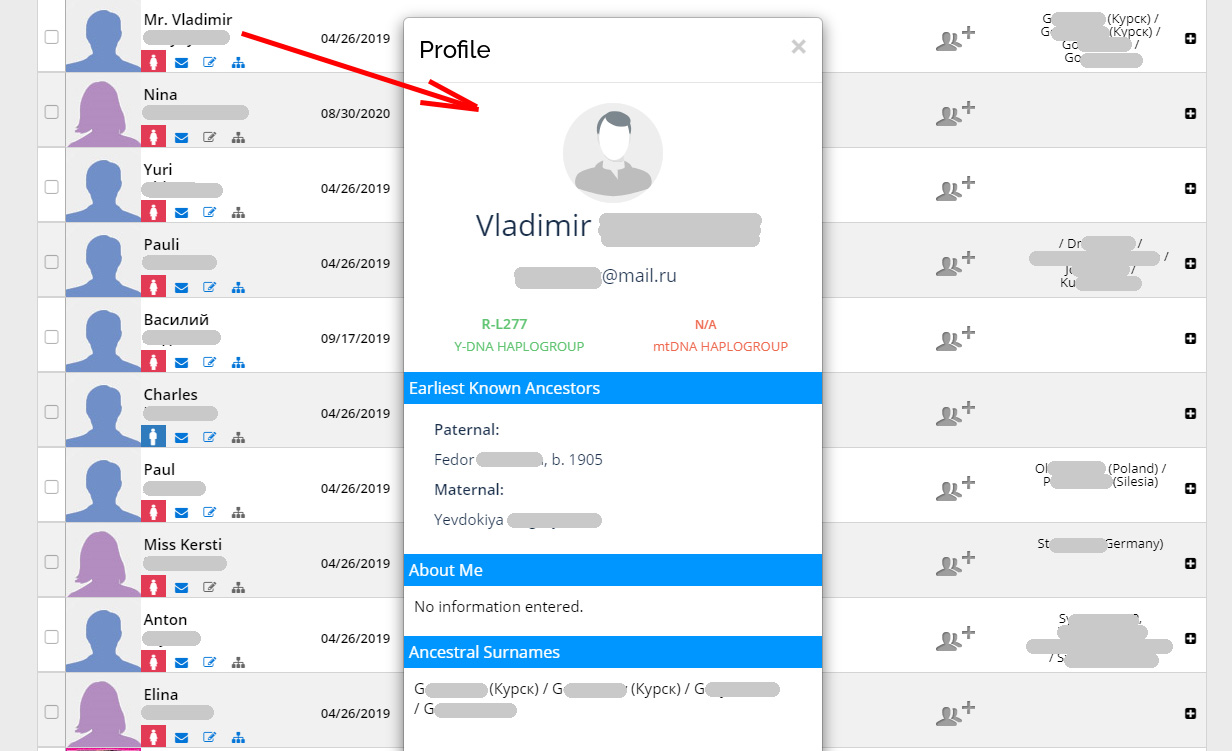
Naturally, the filtering system is supported and the ability not only to automatically filter for the male and female lines, but also to manually select the desired person and filter everyone who coincides with him and with you, or vice versa, everyone who does not match with him. Sorting by default is by degree of affinity, but you can filter by both "cM" and the longest section of shared DNA.
Naturally, on the site it is also possible (and necessary) to make a copy of your tree and this allows us to look at the coincident's tree, to look for familiar surnames. Naturally, we will not see the living without permission.
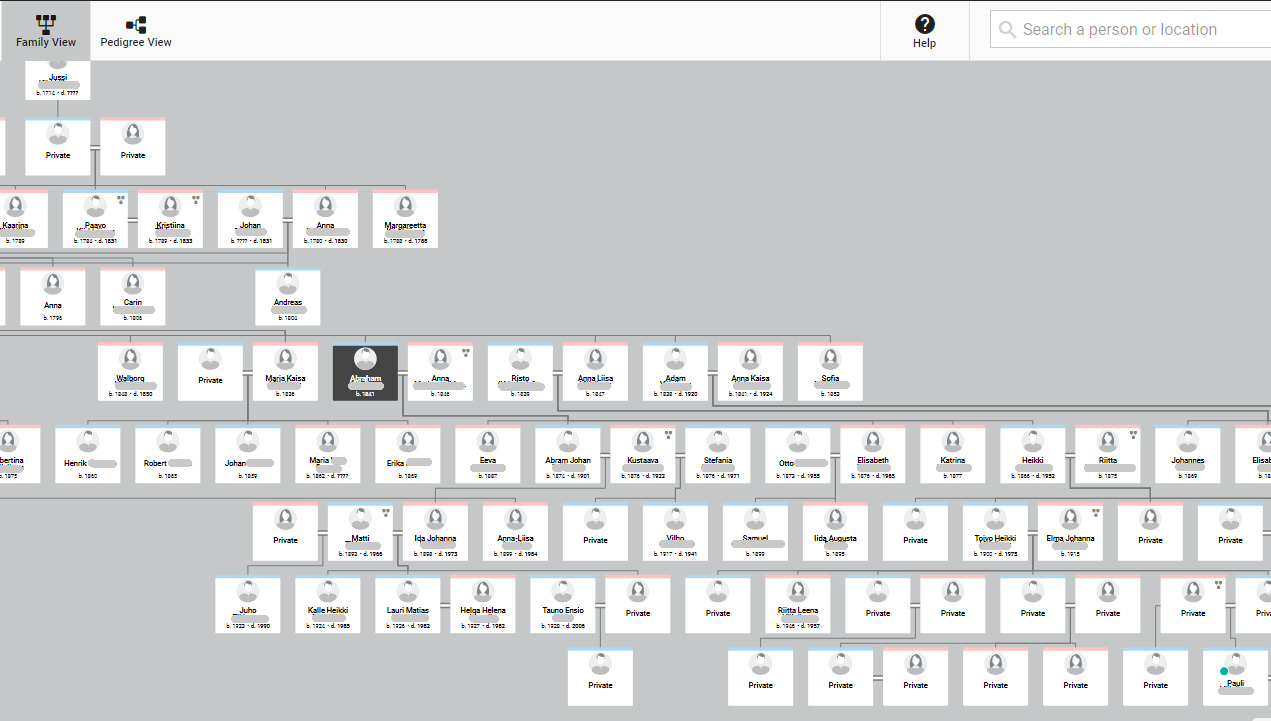
Similarly to “MyHeritage” it is possible to search for common DNA segments between several people other than yourself. This allows you to see both the length of common segments visually and comparison with other people. When there are coincidences in the same block, people are guaranteed to count blood relatives to each other, as in the last screenshot.
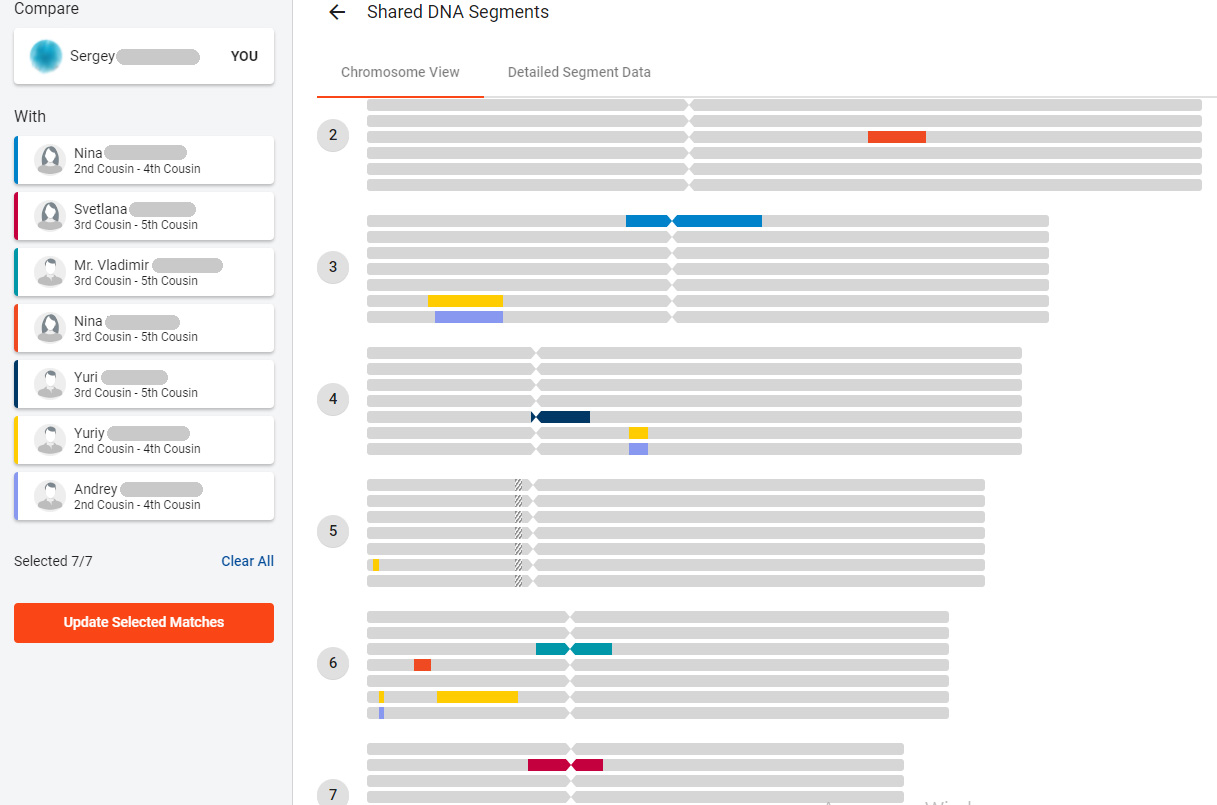

As mentioned above, you can contact a person directly by writing to him by e-mail.
In "FTDNA" you can download the result of a test taken in another laboratory, more on that below.
On all sites, near each person there is a field for notes and notes, visible only to you, there you can make notes for yourself so as not to get confused who and what information gave you. Write down the names and places of residence of the ancestors of those who answered your letters there, because In the process of studying your pedigree, you will revise the "coincidences" over and over again and start from new information, considering this list.
Uploading “Family Finder” DNA Test Results to Other Laboratory Websites
All or almost all sites provide the ability to download the "raw" result of processing your DNA test to your computer. This allows, if technically possible, to upload your test result to other sites.
Those. if the person who passed the test is not advanced enough or is lazy, then the result of his test will be, for example, only on the “MyHeritage” website. Can you imagine how many such people are and how much the lists of "matches" with you on several laboratory sites can differ?
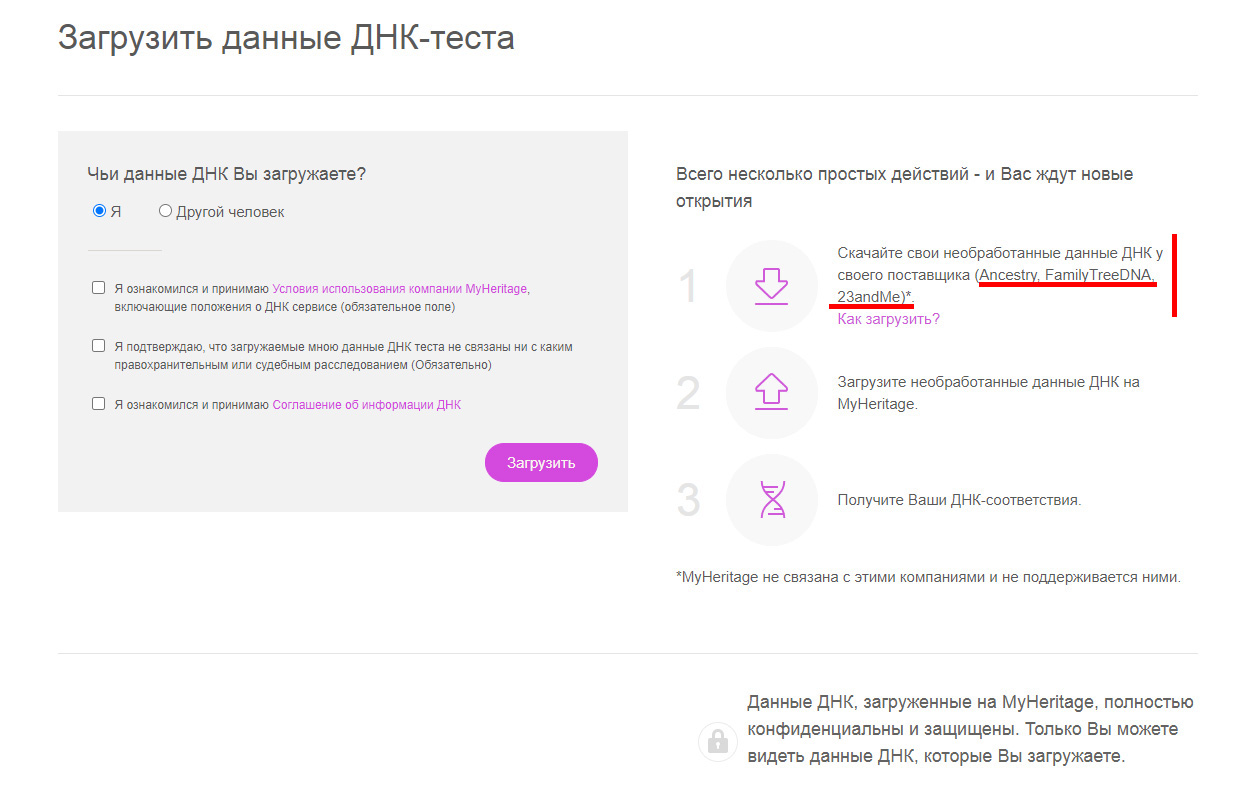

The technical result of the "Ancestry" test can then be uploaded to both "FTDNA" and "MyHeritage". Test results “MyHeritage” and “FTDNA” are interchangeable and are uploaded to each other's sites. The possibility of other tests is reflected on the laboratory websites and screenshots below. And any test can and should be uploaded to a site that compares all tests of all laboratories, and absolutely free. This is the “GedMatch” site.
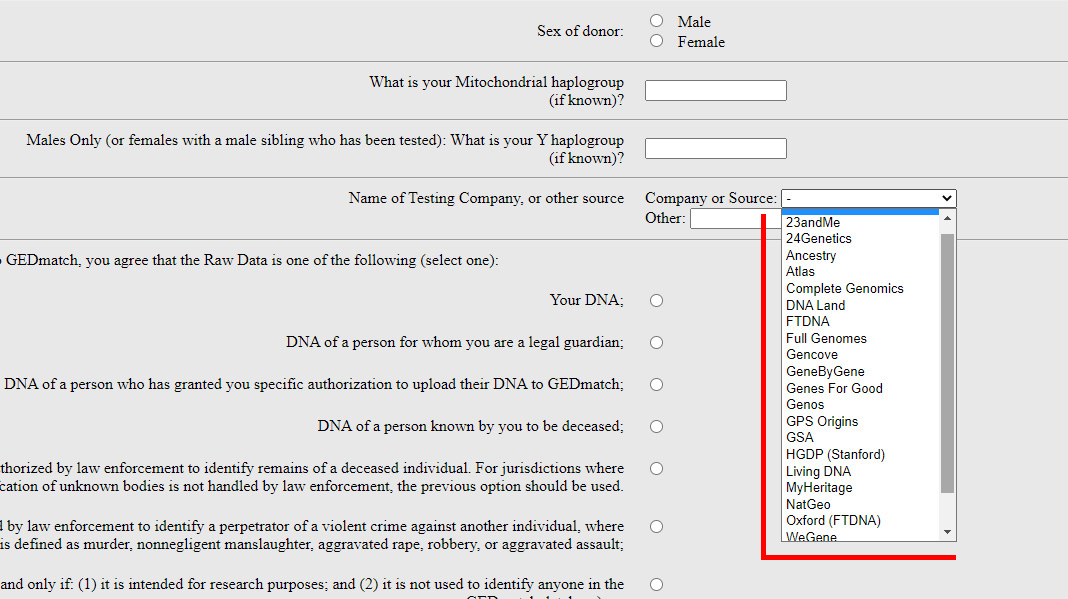
This will allow you to reach a much larger audience, do not neglect this opportunity!
Viewing Autosomal DNA Test Results on GedMatch
“GedMatch” has a very concise and English-language interface. For many, this causes difficulties. But automatic website translators will help.
The site allows you to store data on all DNA tests you manage in one account, and quickly switch between them. There are various “reports” that allow filtering and analysis.
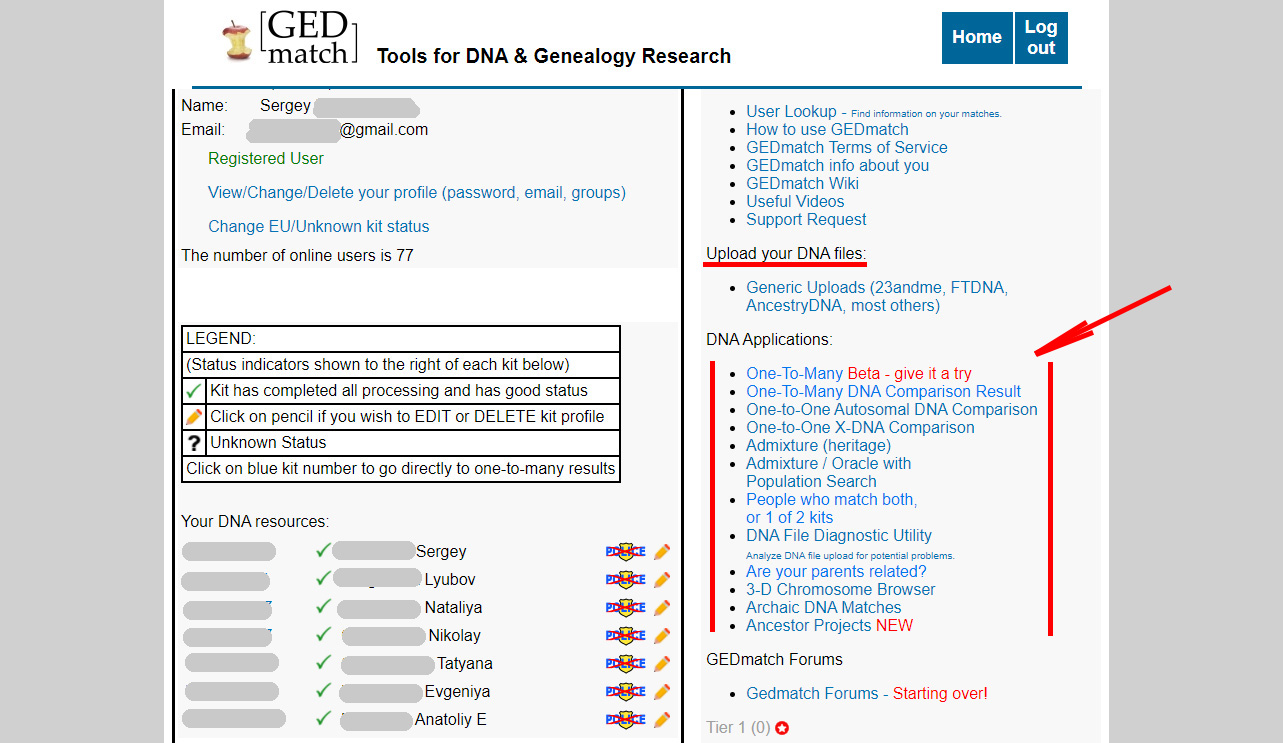
The main window of the site simply displays a list of matches for the test with the last name and first name, e-mail for communication, and shows which part of the DNA matched and which is the longest block, shows the estimated number of generations before the common ancestor and from which laboratory the test was imported.
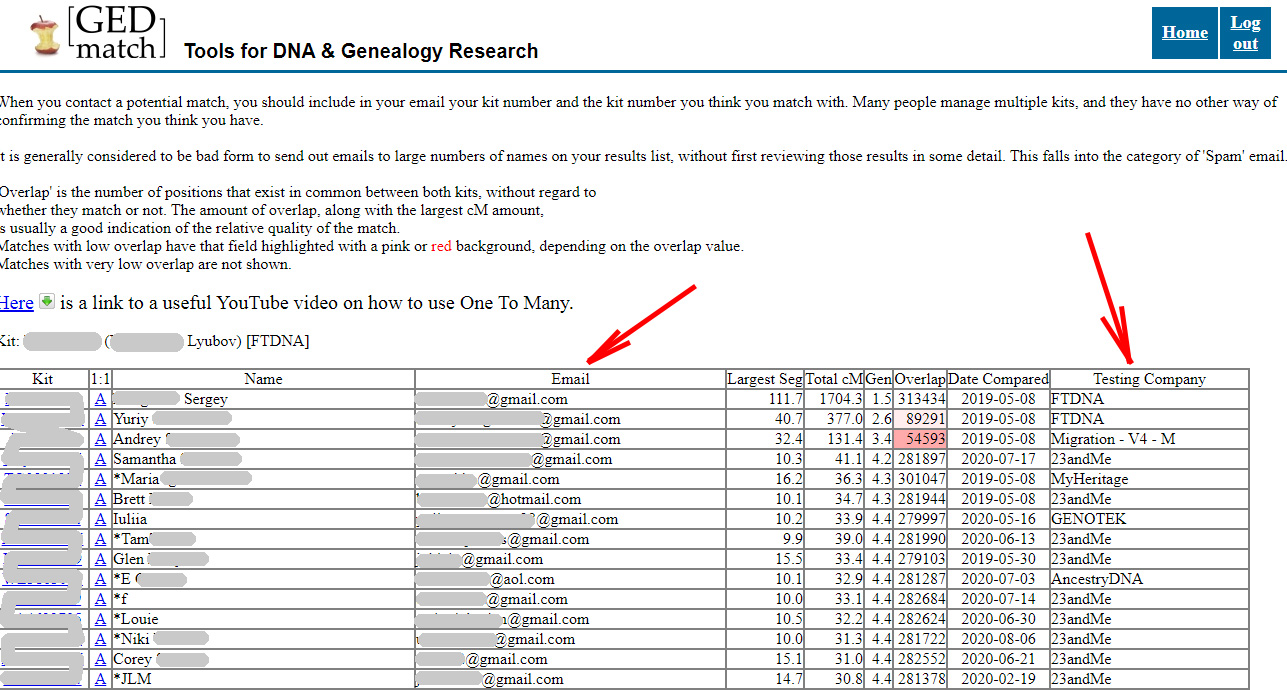
Thanks to this site you will be able to compare with sites closed for import of results, such as for example “23andMe”. If the person was not too lazy and uploaded the test here - everyone will be here!
Viewing Y-DNA Test Results on FamilyFteeDNA
As I discussed in another article , DNA tests are not limited to "autosomal" tests and you can do yourself a male line test or a female line test. Viewing the results of these tests is similar to viewing the results of autosomal tests, but there are slight differences.



For example, in the "male" Y-dna test, it all depends on whether you did the test for only 25 markers, for 37 or 67 markers, or immediately did the test for 700 markers. The more “accurate” the test (the more markers), the less you will see “matches”, and the easier it is to understand when approximately you had a common ancestor. In any case, all of these common ancestors will be far enough away compared to the autosomal test, but you can clearly trace the line where these ancestors lived.

You can filter by markers, by distance, you can see all the matches on the map (the places of residence of distant ancestors are indicated by the users themselves), you can filter the participants of specific projects (the site has the ability to join family or ethnic projects and create such projects yourself). You can see their haplogroup and naturally, you can contact each of them. But before writing a letter, you need to understand something like the following (data taken from the forum on DNA genealogy forum.molgen.org):
(. . 50 ), -.
, 1 31,5 .
, (2 67 )]:
17- Yfiler
1 17 — 12
2 17 — 24
3 17 — 37
4 17 — 52
4 17-
25-
1 25 — 11
2 25 — 23
3 25 — 35
4 25 — 47
4 25- — 37
37-
1 37 — 6
2 37 — 11
3 37 — 17
4 37 — 24
5 37 — 30
6 37 — 36
7 37 — 43
8 37 — 50
8 37- — 67
67-
1 67 — 3
2 67 — 7
3 67 — 11
4 67 — 14
5 67 — 18
6 67 — 22
7 67 — 26
8 67 — 29
9 67 — 33
10 67 — 37
11 67 — 41
12 67 — 46
13 67 — 50
13 67- — 111 .
111-
1 111 — 2
2 111 — 4
3 111 — 7
4 111 — 9
5 111 — 11
6 111 — 13
7 111 — 16
8 111 — 18
9 111 — 21
10 111 — 23
11 111 — 25
12 111 — 28
13 111 — 30
14 111 — 33
15 111 — 35
16 111 — 38
17 111 — 40
18 111 — 43
19 111 — 45
20 111 — 48
Accordingly, in the screenshot above, on 67 markers, there is a "coincidence" at 4 steps, which means a common ancestor with him on a time interval of 441 years or more (from 14 generations to 31.5 years). And in the screenshot with 37 markers, there is a "coincidence" at 3 steps, and with it a common ancestor at a distance of 535 years or more (from 17 generations to 31.5 years). But these are guaranteed "relatives" with a guaranteed common ancestor in the direct male line! Regarding the migration of your haplogroup (the very first picture in the article), there are very large scientific articles that you can read.
Absolutely similar with the Mt-DNA test, where a straight female line is considered. Viewing test results on the website is similar.
Thanks to everyone who mastered this article!
I tried to describe everything as simply as possible.